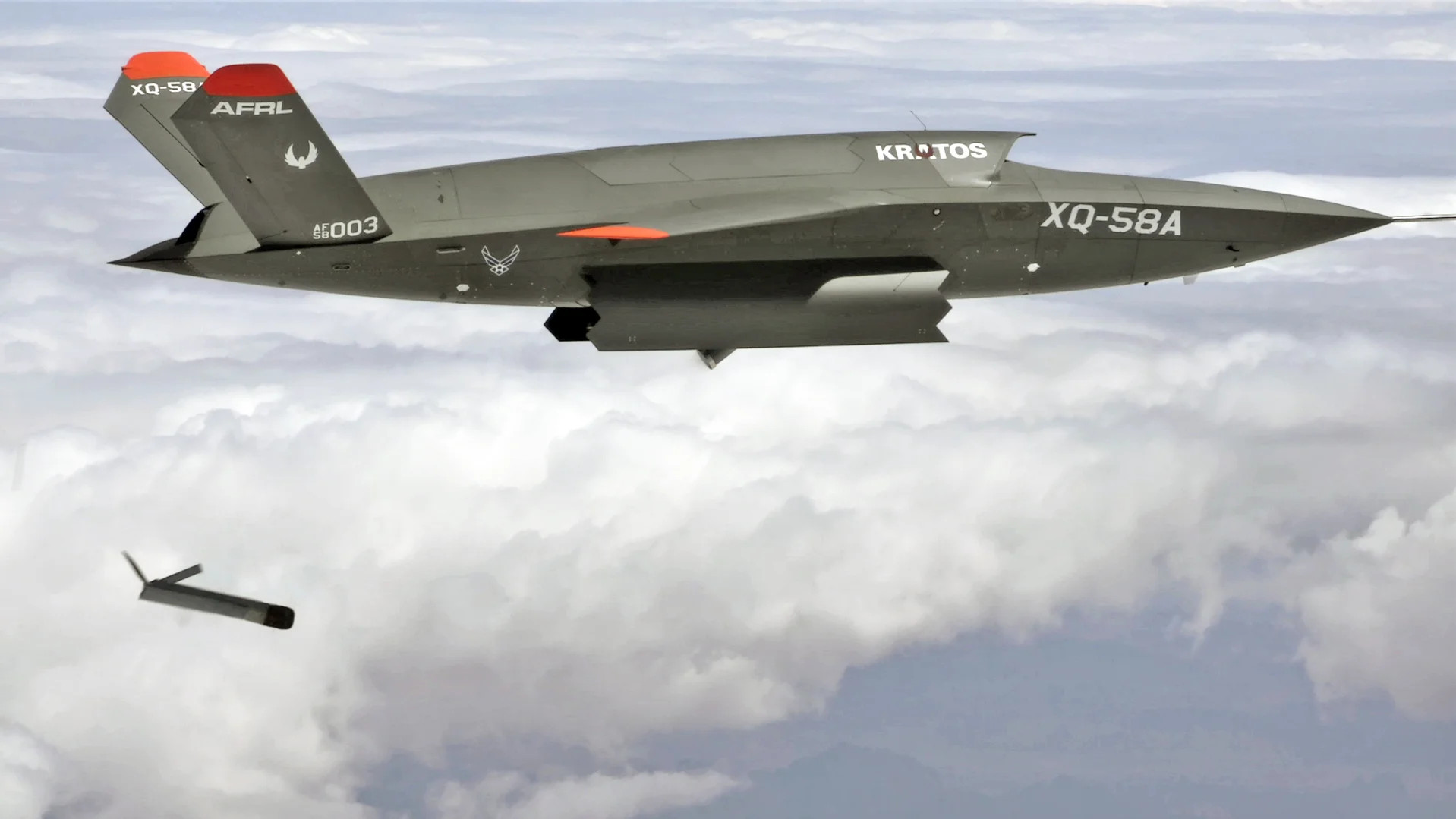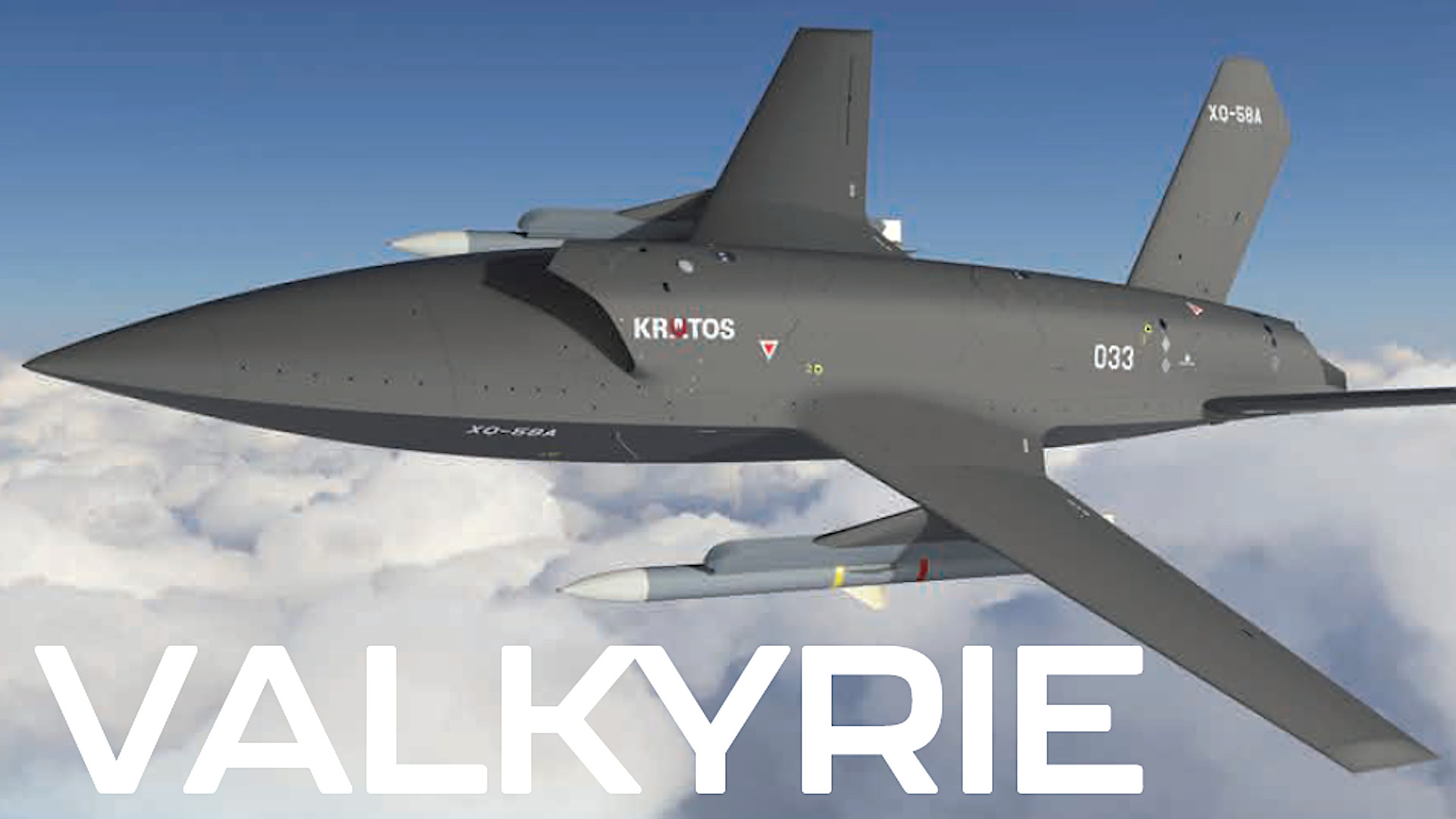Five years after the first flight of its stealthy XQ-58A Valkyrie, Kratos has confirmed that there are now at least five different variants of the drone either in production or development. The company is also continuing its work to drive down the unit costs of these uncrewed aircraft, something that could be particularly relevant as it looks to make a bid for the next round of the Air Force’s Collaborative Combat Aircraft program.
Kratos has previously disclosed the existence of additional XQ-58 variants, including one with improved performance, but has otherwise provided few details. Development of the original Valkyrie, which the company also refers to as the Increment 0 design, dates back at least to the early 2010s, and the drone first flew on March 5, 2019.

In a statement to The War Zone this week, Kratos CEO Eric DeMarco said that the full XQ-58 family now includes an Increment 1 or Valkyrie A variant, as well as B, C, and D versions. He added that the C and D types, specifically, “are far more capable aircraft” than their predecessors.
Since at least 2020, Kratos’ website has said the XQ-58A has a cruising speed of Mach 0.72, the ability to fly at altitudes up to 45,000 feet above sea level, and a maximum range of approximately 3,000 miles. The drone’s stated maximum launch weight is 6,000 pounds. In November 2022, the company announced that what it described at the time as a “Block 2” Valkyrie had demonstrated its ability to fly further and higher, as well as with a heavier overall weight, than any previous version.

“More capable” could also refer to improved mission systems and other capabilities. A more recent company rendering of an XQ-58, seen at the top of this story, shows an example with a pair of AIM-120 Advanced Medium Range Air-to-Air Missiles (AMRAAM) under its wings. The Valkyrie can also release munitions and other stores from an internal payload bay.

From the beginning, the Valkyrie has also had the attractive benefit of being runway independent, which offers additional operational flexibility as The War Zone has highlighted in the past. XQ-58s make use of a rocket-assisted takeoff method via a launcher on the ground, as can be seen in the video below, and land using a parachute recovery system at the end of a sortie. Kratos has shown a launch system that fits inside a standard shipping container in the past, which opens up additional rapid deployment options.

The War Zone has reached back out for more information about the specific differences between the five different versions of the Valkyrie.
In his statement to The War Zone, Kratos CEO DeMarco also mentioned an “Off Board Sensing Station System type configuration” for the Valkyrie. Off-Board Sensing Station, or OBSS, is a U.S. Air Force term that first emerged publicly in 2021 with the announcement of an Air Force Research Laboratory project with that name. Kratos and General Atomics were subsequently awarded contracts to develop OBSS drone designs. In 2023, AFRL selected General Atomics to continue work on OBSS alone, which led to the development of the XQ-67A drone that flew for the first time on February 28 of this year. The War Zone was first to report on the unveiling of the XQ-67A and you can read more about what is known about its design here.
A rendering Kratos previously released of the OBSS design, which the company called Demogorgon, showed a design that is distinct from the XQ-58, though the two do share some very broad similarities in their general arrangement. It is unclear how exactly the OBSS-configured Valkyrie does or doesn’t relate to Demogorgon. An OBSS Valkyrie could off a runway-independent version of this capability, which we will come back to later. While it is unknown how Demogorgon was designed to take off and land, General Atomics’ XQ-67A is a traditional runway-bound design with retractable tricycle landing gear

In terms of what is now known about OBSS, earlier this year, AFRL disclosed that the core concept was a direct outgrowth of its Low Cost Attritable Aircraft Technologies (LCAAT) initiative, which dates back to 2014. The XQ-58 was originally developed for the Air Force’s Low Cost Attritable Strike Demonstrator (LCASD) project, another offshoot of LCAAT. AFRL has also now revealed the existence of a companion Off-Board Weapon Station (OBWS) concept, details about which remain scant.
“The OBSS was viewed as slower while carrying sensors but have longer endurance, while the OBWS was considered faster and more maneuverable, with less endurance but better range,” according to AFRL.
The OBSS and OBWS concepts were both crafted as part of the Low Cost Attritable Aircraft Platform Sharing (LCAAPS) project, another effort that branched out from LCAAT. LCAAPS’ core focus was on exploring new and improved design and manufacturing methods to help accelerate the development and production of new drones and do so at a lower cost. You can learn more about what is now known about all of these intertwined Air Force drone projects here.
For years now, Kratos has been at the forefront of discussions about finding an affordable balance between costs and capabilities with respect to the mass production of higher-end drones like the XQ-58A. The company has said in the past that it hoped to be able to get the unit price of the Valkyrie down to around $2 million, a cost comparable to or even cheaper than the price tags of many expendable missiles.

“The $2M unit cost for Valkyrie Inc 0 was achievable as determined when detail costed out and validated in 2015/2016 related to Valkyrie program initiation,” Kratos CEO DeMarco explained in his statement this week to The War Zone. “There have [been] Configuration Changes since these Original Configurations and also inflation and cost increases across virtually every cost input element over the past 9 years since that time, which have impacted these initial large quantity objectives.”
“Current unit costs of Valkyrie Inc 1 or Version A based on actual cost data on Lot 2 in process production is approximately $5.5M including all required Test, Launch and other support equipment, at quantity,” DeMarco added. “Per a customer request, we have recently prepared a Rough Order of Magnitude (qualified and verified vendor costing) 100 Aircraft Costing for Valkyrie Version B at approximately $4M each.”
“We also provided to a customer a ROM for a much larger quantity (several hundred) Valkyrie A variants, which costs were much less than the 100 ROM costing noted above,” he continued. “We have also provided several additional qualified ROM costing analysis [sic] to a separate particular customer for various Lot Sizes of Valkyrie A and B, ranging from $5M to $6M per aircraft, depending on quantity and delivery schedule timing (very quick). The costs above are for Fly Away Aircraft Systems.”
DeMarco said he could not currently provide any cost information relating to Valkyrie C or D “for competitive reasons.”

In addition, “we have targeted and are progressing towards [a] cost of approximately $800 per pound for an Off Board Sensing Station System type configuration, which we will achieve, and which methodologies will also further reduce the costs of Kratos Valkyrie (all versions) and other Kratos drones, once applied,” DeMarco said.
When talking about aircraft, cost per pound typically refers to the price of everything that goes into a design, crewed or uncrewed, from raw materials to engines to mission systems, divided by its gross weight.
“I didn’t realize this until I started working with industry and in Congress, but we buy aircraft by the pound, which is, it sounds nuts, but if you go back and look at the analysis, it’s about $2,500 per pound to buy a military aircraft,” Robert Winkler, Kratos’ vice president of Corporate Development and National Security Programs, said at an event hosted by the Air & Space Forces Association’s Mitchell Institute back in 2022. “AFRL has done a fantastic job and doing some really innovative development, and they’ve brought that down by a quarter. So now we’re talking about 600 pounds for $600 per pound, which is fantastic and honestly revolutionary.”
It’s unclear what customers or potential customers Kratos has been doing these cost analyses for and who might be in line to buy newer, more capable Valkyrie variants. To date, there are only two known operators of the XQ-58A are the U.S. Air Force and the U.S. Marine Corps. Valkyrie’s runway independence is particularly relevant to the concepts of operations the Marines have been developing and refining in recent years, which focus heavily on distributed and expeditionary deployments to remote and austere locations.

Later this year, a Valkyrie equipped with Shield AI’s Hivemind artificial intelligence (AI) driven autonomy software package is also expected to fly in support of the Defense Advanced Research Projects Agency’s (DARPA) Air Combat Evolution (ACE) program. It’s unclear who will supply the XQ-58, and what version it will be, for the ACE testing. The Air Force has used its XQ-58As in the past to support a variety of advanced autonomy and other test work.

From what Kratos’ CEO DeMarco has now told The War Zone, the new developments regarding the growing Valkyrie family do look particularly relevant to the Air Force’s CCA program. The need to find cheaper ways to develop and build very large volumes of drones and to do so relatively quickly have been key drivers behind the CCA effort, as you can read more about here. The Air Force already plans to acquire hundreds, and more likely thousands, of CCA drones through at least two iterative development cycles.
CCA drones are being developed now under the program’s initial phase, also known as Increment 1. Kratos was notably not among the contractors selected in that first round, but has publicly expressed its interest in securing a contract as part of the program’s Increment 2. The Air Force is still firming up its specific requirements for Increment 2, but expects to award the contracts for that phase in the 2025 Fiscal Year, which begins in October of this year.
CCA’s Increment 2 could be the first to involve foreign participation, which could also point to more simplified requirements. The War Zone laid out a case for this kind of integration of foreign allies and partners into the CCA program, or an adjacent effort, in an in-depth feature last year, which you can check out here.
Other branches of the U.S. military are already actively collaborating with the Air Force on relevant technologies, including control architectures to allow seamless transfer of control of future drones from one service to another during operations. Other U.S. military services and foreign countries who are pursuing their own advanced drone programs could also be among the future buyers of XQ-58 variants.
No matter what, Kratos has clearly been investing significantly to expand its flagship XQ-58 line to be better positioned to meet current and future requirements from the Air Force and other potential buyers.
Contact the author: joe@twz.com
